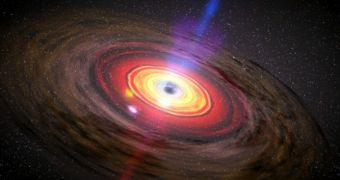Astronomers are beginning to become increasingly aware of the fact that supermassive black holes (SMBH) probably played a critical role in the early development of galaxies. They are now trying to determine the evolutionary history of the black objects themselves.
But studying black holes, SMBH or otherwise, is tremendously difficult, mostly because direct measurements cannot be conducted on them. Their gravitational pull is so strong that they don't even let light escape them.
Such structures form from the collapsed cores of massive stars, hundreds to thousands of times heavier than the Sun. When their reach the end of their burning cycle, they eject their atmosphere, leaving their cores bare.
As this happens, the central regions become destabilized and implode, collapsing in on themselves to form either black holes or neutron stars of different flavors. Only the most massive cores become black holes.
Even stars that become neutron stars can later become black holes, if they accrete enough mass from their surroundings. Once a certain threshold is reached, the star destabilizes too, and collapses further.
Until now, no direct observations of black holes have ever been made. All the evidence we have to support theories showing they exist are indirect, derived from tracking the behavior of stars around the cores of massive galaxies such as our own.
What puzzled astronomers in past studies was discovering a direct correlation between the mass of the SMBH and the size of the bulge the galaxy hosting it had. Some theories suggest that black holes were the seeds around which the earliest galaxies developed.
The most recent science on black holes shows that the SMBH do not consume the galactic bulge in order to grow. Rather, it would appear that the two grow in tandem. This has great implications fo how the early Universe looked like.
Unrelated studies have demonstrated that the Cosmos was a lot smaller and denser in its early days than initially thought, which means that the beginning of stars, galaxies and black holes may have happened suddenly.
Most astronomers now agree that gas and dust accumulations were the first to develop. Massive stars coalesced from these clouds, and then turned into black holes, which continued to grow through accretion – the gulping up of surrounding dust and gas.
But SMBH limited their own growth through the radiation and polar jets they emitted, which ultimately drove the cosmic material that had not already been trapped by the accretion disk away into space.
In this outer regions, the materials – still powered from angular momentum – were able to come together and form nebulae, areas that form new, blue stars at a frantic pace.
By blowing out excess material, the SMBH began participating actively in the growth of new galaxies, which formed all around them, Universe Today reports.
Like all relationships, this too features a critical point, which is a built-in limitation placed on the growth of the SMBH and its galaxy. The point is reached when the black hole emits as much material as it engulfs through accretion.
The only method for those massive galaxies to grow any further is by merging, or cannibalizing, with other similar galaxies. The SMBH may combine too,giving birth to monstrous black holes.

 14 DAY TRIAL //
14 DAY TRIAL //